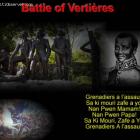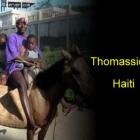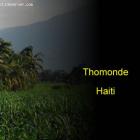ADVERTISEMENT
carnival - Haiti Observer Blog
carnival, Haiti Observer Blog. Read the following articles about carnival
Chaloska, The story of Charles Oscar and Carnival
The story of Chaloska goes as follows, Chief Charles Oscar was a military commander in charge of the police in Jacmel. He was feared by many
The specific things that made him a distinct figure is that he was tall and strong, with big teeth.
His story became one that crosses several generations in Haiti and somehow stays with the time.
It came at a time of great instability in Haiti, politically and socially. President Vilbrun Guillaume Sam was forced to contend with a revolt against his government, led by Dr. Rosalvo Bobo. Unable to do so, he fled to the French embassy, where he received asylum. The mulatto rebels broke into the embassy and captured him. The Haitian president was beating to death and his cadaver ripped into pieces and paraded the parts through the capital's neighborhoods.
Kanaval Des Etudients in Haiti
Carnival of students usually takes place on the last Friday before Dimanche Gras, Lundi Gras and Mardi Gras. This is jubilation created specially for the students of various schools in Haiti.
In the old days, Carnival des etudients was particularly important. it was the time when the various schools in Haiti would compete to demonstrate who would be best represent the values of their schools
During that time, hundreds and thousands of participants and many university students are in the parade. You can watch some of the best carnival floats and music, colorful dances and musics touring the city. The same way the students are having fun, thousands of people gathering on both sides of the streets to take part of the ambiance and
Les Difficiles de Petion-Ville during Carnival in the 1970's
Here is a picture that I want to share with you. Difficiles de Petion-Ville during Carnival in the 1970's. This was a time of great competition between the Mini-Jazz such as Difficiles, Gypsies and many others. Back in the old days, I was tod that Carnival in Haiti was something special in a sense that it was better organized.
Some of the things I personally remaked. One the competition or the "Polemic" between the musical bands were more discrete. Back in the 1970's and the 1980's, the bands were not involved in name calling. It was left to the imagination of the fans to interpret the various statements. This is unlike today where any one is able to call any other anything. No statement is left to the imagination today
Image of Carnival in Cap-Haitian back in 1952
There is a big difference in the way Carnival in Haiti was some years ago. Many of the old school would tell you that Carnival in the old days was more about Costums and display of color and history in Haiti. They do not think that the same concept exists today
What do you think about Carnival of today vs yesterday. By yesterday, I mean Kanaval of the old generation?
Do you think there have been inprovement of like some, do you believe there has been a decline?
Jacmel Mardi Gras Smashes Stereotypes
Jacmel is a city unto itself. Lying on the coastal waters of the Caribbean Sea, its celebration of Carnival knows no parallel elsewhere in Haiti. The focus of Carnival in Jacmel is Mardi Gras, the day before Lent begins with Ash Wednesday. Christians on this feast day receive a smudge of ash in the form of a cross on their foreheads, signifying repentance.
While other cities across Haiti celebrate Carnival with crowds of jostling dancers in traditional garb, Jacmel turns these entrenched practices on its head, preferring to stage impromptu theatre pieces in random spots along its streets.
Jacmel Carnival Symbol of Haiti Self-Determination
When Carnival season begins in Haiti, the seaside city of Jacmel divides its celebration into two halves. In the daytime, some celebrants meander through the streets dressed up in colorful paper-mache outfits, while others cover their bodies in shiny, black paint and wield ropes as imitation whips. They are addressing Haiti's slave history and the subsequent slave revolt.
Another roving group, the Chaloska, move through the streets in blood-red and black costumes, their faces decorated with over-sized lurid, red lips and monster fangs. They symbolize the 1915 bloody assault carried out on jailed political dissidents by the local police chief.
Haitian Mardi Gras
Haitians consider Carnival the onset of one of the most sacred periods of the year. It precedes Mardi Gras, celebrated on the last day of the festival, which leads into Lent, a period of fasting and atonement.
Mardi Gras is also called Fat Tuesday, symbolized by consuming all forms of fat. Succeeding Mardi Gras is Ash Wednesday, which initiates the Lenten season in the Roman Catholic Church. Fasting and avoidance of meat characterize Lent. Carnival, in this light, can be looked upon as the final chance to feast, drink, and dance with abandon.
Carnival in Haiti can be likened to Christmas in the U.S. and Northern European countries. The Yuletide season encourages celebrations of music, food, and traditional entertainment events. Carnival is not only a coming together of many cultures; it is also an engine of economic wealth for Haiti, whose sources of revenue are limited.
Haiti Prepares for Carnival in Cap-Haitien
As part of its decentralization program the government of Haiti (GOH) has implemented since President Martelly assumed office, the city of Cap-Haïtien has been selected to be the venue for Carnival 2013. The event will be held on February 10, 11, and 12.
Ms. Elsa Baussan, representative from President Martelly's administrative staff, attended a meeting of the North-Area Office of the Ministry of Tourism (MOT) to plan the execution of Carnival in Cap-Haïtien. After the meeting, she spoke with the press, expressing President Martelly's desire tourists become acquainted with the "historical uniqueness of every region of the country"
Ardrouin Zéphyrin, North-Area's MOT representative, elated about the selection of Cap-Haïtien as Carnival's host, has committed all his department's resources to ensure the event is successful.
Haiti 2013 National Carnival is set for Cap-Haitian
The dates and the place for the next Carnival in Haiti has been scheduled. It will take place on February 10, 11 and 12 in the historic Haitian city of Cap-Haitian. Ms. Elza Beaussan who is at the head of the delegation visited Cap-Haitian on December 18, 2012 to begin the preparation for this big event.
After the city of Les Cayes last year, now it is the turn of Cap-Haitian to host the biggest event of the year which is the Carnival. This is part of the decentralization plan for the current government as they are using this annual event to help discover the entire country of Haiti
Haitian Carnival in Little Haiti - With reopening of the Caribbean Market Place
February 18, 2012 will be a day like no other on the streets of Little Haiti. On this historic day more than a thousand Haitians are expected to show up on the streets to make merry, to dine and wine, to dance to soul soothing music, but most importantly to make the world believe that the fading tourism industry in the Caribbean country can be revamped. For the first time Haitians living in Miami will hold their own celebration in Little Haiti, also known as the Lemon City.
The event organized by the office of Commissioner Michelle Spence-Jones with the support of a number of sponsors will announce the reopening of the Caribbean Market Place in Little Haiti, which has not seen the light of day since 1997. It will be preceded by an event dubbed Big Night in Little Haiti to be held on 17th February at the Little Haiti cultural centre.
Our objective is to share with you news and information about Haiti and the people of Haiti. Traditions, habits and the way we were or grew are alive in this site. We highly recommend that you Subscribe to our Newsletter and also share with us some of the things that are memorable and made us unique people.

 Battle of Vertieres
Battle of Vertieres  Haitians are a Proud People
Haitians are a Proud People  Thomassique, Haiti
Thomassique, Haiti  Thomonde, Haiti
Thomonde, Haiti  Haitian Thanksgiving
Haitian Thanksgiving